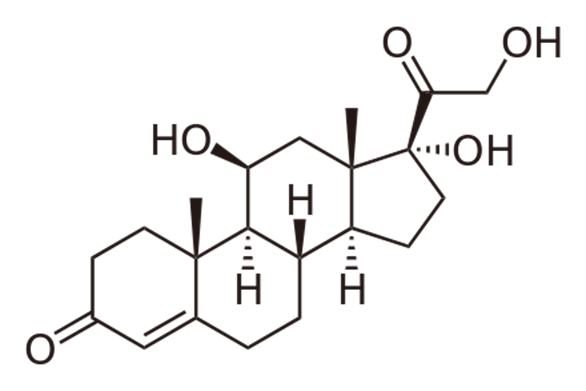|
Cholesterol Bile,
membranes, hormones, vitamins and untimely death (and more) Molecule of the Month - March 2014 |
|
![]()
Ben
Benjamin Torbay Hospital, Devon, UK
![]()
What is cholesterol?
Cholesterol
is a large and complicated molecule. It is vital animal life cannot exist
without it. It can be made by all cells in our body built up from simple
small molecules. But it also has a dark side our bodies dont seem to be able
to get rid of cholesterol and it can build up in arteries to cause blockage
and death from heart attacks and strokes.
Why is it called cholesterol?
Cholesterol
was first identified in bile. That is why it is called cholesterol chole- means of
bile sterol refers to the four-membered ring which is very common in nature
see http://www.cyberlipid.org/sterols/ster0003.htm
How is it made?
The starting
point for cholesterol synthesis is acetic acid, or vinegar. This is 2-carbon
molecule which can be made from fat, sugars such as glucose and from proteins.
Further bits are added on in a stepwise fashion until it is 30 carbon atoms squalene.
Squalene is a useful substance it is used to make earwax.
|
|
|
|
|
|
It takes
over 30 biochemical steps to make cholesterol from acetic acid. HMG Co-A reductase is the rate-limiting enzymatic step for
cholesterol synthesis and is the target of statin drugs such as simvastatin.
These drugs are very widely used to reduce cholesterol synthesis. Atorvastatin,
invented by chemists at Parke-Davis has achieved
sales of over $100 billion dollars since it was introduced in 1996.
What about cholesterol in our diet?
Most
cholesterol in our diet comes from animal products. Egg yolks have a lot, so does
some seafood, such as shrimps. Milk has quite a lot, because milk contains fat
globules which are surrounded by a phospholipid bilayer (see below). The
evidence suggests that cholesterol in our diet is not as important as the
cholesterol we make ourselves in causing problems. It used to be thought that
plants do not contain cholesterol, but that is not entirely true see: http://bip.cnrs-mrs.fr/bip10/choles.htm
Why go to all that bother?
The main use
for cholesterol, and other sterols, is to make better cell membranes. Cell
membranes are principally comprised of phospholipids. These are long molecules
with a hydrophilic phosphate group attached to long hydrophobic hydrocarbon
chains. Phospholipids naturally form themselves into hollow balls known as
micelles see:
http://hyperphysics.phy-astr.gsu.edu/hbase/organic/phoslip.html.
All the
cells in our body have a membrane around them made of a double layer of
phospholipids. The trouble with phospholipid membranes is that they are too
leaky. It is important to keep small molecules such as water and ions (like
sodium and potassium) on one side or the other. Cholesterol is incorporated
into the membrane to make it stiffer, less floppy and less leaky. This is
particularly important in nerve cells which need to keep ions in the right
place. As a result, brains contain a lot of cholesterol.
Cholesterol, bile and gallstones
Cholesterol
is the starting point for the manufacture of bile acids and bile salts. These
compounds are excreted in the bile as detergents, along with cholesterol and
phospholipids. The function is to emulsify fats we eat, and make it easier to
digest them. Bile is a complicated mix of cholesterol, bile acids and
phospholipids, which sometimes goes wrong and cholesterol (which is quite
insoluble in water) precipitates out of solution and makes stones.
|
|
|
|
|
|
Hormones
Cholesterol
is the starting point for a number of really important hormones. The most
important is cortisol, made by the adrenal glands (small glands which live on
top of each kidney). It is called cortisol because it is made by the adrenal
cortex (the outside bit) and regulates a whole range of metabolic processes. We
cannot survive without cortisol.
 cortisol
cortisol
Sex hormones
made from cholesterol include testosterone (which increases muscle strength and
makes men look like men) oestrogen and progestogens
which are female hormones necessary for normal menstrual cycles and pregnancy.
 testosterone
testosterone
Vitamin D
This vitamin
is made from cholesterol in the skin, using the energy of sunlight to convert
7-dehydrocholesterol to cholecalciferol. Vitamin D is
vital for healthy bones and a good functioning immune system. The disease
rickets is caused by a lack of vitamin D in the diet together with not enough
sunshine
Why is cholesterol bad?
If we eat
too much saturated fat, this gets incorporated into our cell membranes.
Saturated fat has straight, rather than bent lipid chains. This means that the
membranes need less cholesterol to keep them stiff and prevent leakage. But our
liver still makes lots of cholesterol in the form of LDL (low density
lipoprotein). Our cells are not interested in taking it up and it becomes
oxidised and taken up into the lining of blood vessels. This cholesterol forms
a lump inside the artery known as an atheromatous plaque.
After many years this plaque can rupture and cause a blood clot to form in the
artery. If it is a coronary artery this will result in a heart attack. If it is
a brain artery the clot will cause a stroke.
|
|
|
Further reading:
Theres lots more about cholesterol on my blog: wardroundstuff.com
![]()
![]() Back to Molecule of the Month page. [DOI:10.6084/m9.figshare.5398438]
Back to Molecule of the Month page. [DOI:10.6084/m9.figshare.5398438]










